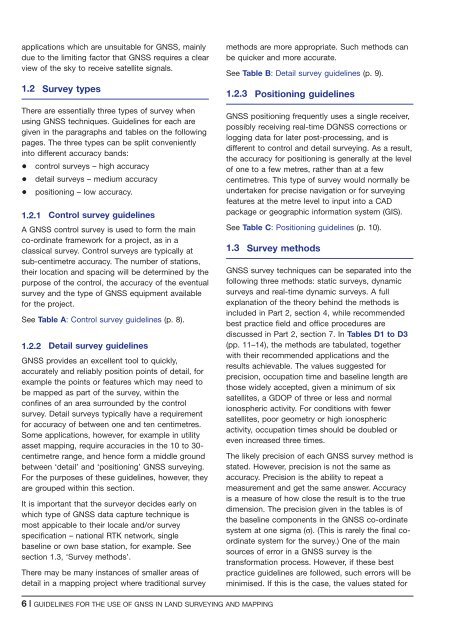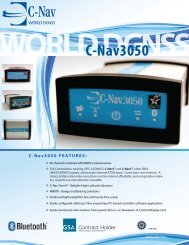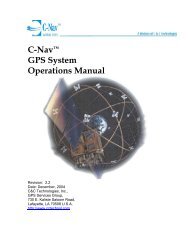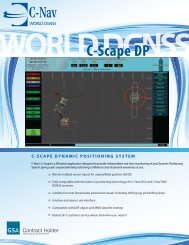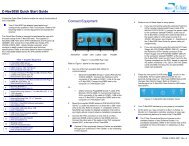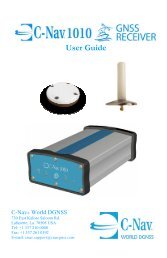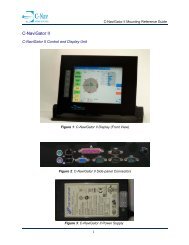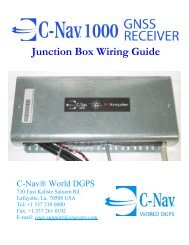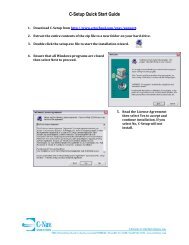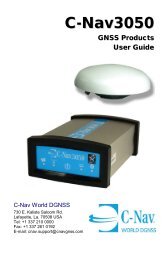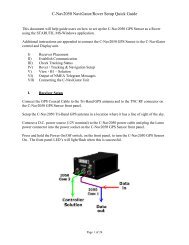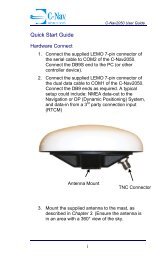Guidelines for the use of GNSS in surveying and mapping
Guidelines for the use of GNSS in surveying and mapping
Guidelines for the use of GNSS in surveying and mapping
Create successful ePaper yourself
Turn your PDF publications into a flip-book with our unique Google optimized e-Paper software.
applications which are unsuitable <strong>for</strong> <strong>GNSS</strong>, ma<strong>in</strong>ly<br />
due to <strong>the</strong> limit<strong>in</strong>g factor that <strong>GNSS</strong> requires a clear<br />
view <strong>of</strong> <strong>the</strong> sky to receive satellite signals.<br />
1.2 Survey types<br />
There are essentially three types <strong>of</strong> survey when<br />
us<strong>in</strong>g <strong>GNSS</strong> techniques. <strong>Guidel<strong>in</strong>es</strong> <strong>for</strong> each are<br />
given <strong>in</strong> <strong>the</strong> paragraphs <strong>and</strong> tables on <strong>the</strong> follow<strong>in</strong>g<br />
pages. The three types can be split conveniently<br />
<strong>in</strong>to different accuracy b<strong>and</strong>s:<br />
+ control surveys – high accuracy<br />
+ detail surveys – medium accuracy<br />
+ position<strong>in</strong>g – low accuracy.<br />
1.2.1 Control survey guidel<strong>in</strong>es<br />
A <strong>GNSS</strong> control survey is <strong>use</strong>d to <strong>for</strong>m <strong>the</strong> ma<strong>in</strong><br />
co-ord<strong>in</strong>ate framework <strong>for</strong> a project, as <strong>in</strong> a<br />
classical survey. Control surveys are typically at<br />
sub-centimetre accuracy. The number <strong>of</strong> stations,<br />
<strong>the</strong>ir location <strong>and</strong> spac<strong>in</strong>g will be determ<strong>in</strong>ed by <strong>the</strong><br />
purpose <strong>of</strong> <strong>the</strong> control, <strong>the</strong> accuracy <strong>of</strong> <strong>the</strong> eventual<br />
survey <strong>and</strong> <strong>the</strong> type <strong>of</strong> <strong>GNSS</strong> equipment available<br />
<strong>for</strong> <strong>the</strong> project.<br />
See Table A: Control survey guidel<strong>in</strong>es (p. 8).<br />
1.2.2 Detail survey guidel<strong>in</strong>es<br />
<strong>GNSS</strong> provides an excellent tool to quickly,<br />
accurately <strong>and</strong> reliably position po<strong>in</strong>ts <strong>of</strong> detail, <strong>for</strong><br />
example <strong>the</strong> po<strong>in</strong>ts or features which may need to<br />
be mapped as part <strong>of</strong> <strong>the</strong> survey, with<strong>in</strong> <strong>the</strong><br />
conf<strong>in</strong>es <strong>of</strong> an area surrounded by <strong>the</strong> control<br />
survey. Detail surveys typically have a requirement<br />
<strong>for</strong> accuracy <strong>of</strong> between one <strong>and</strong> ten centimetres.<br />
Some applications, however, <strong>for</strong> example <strong>in</strong> utility<br />
asset mapp<strong>in</strong>g, require accuracies <strong>in</strong> <strong>the</strong> 10 to 30-<br />
centimetre range, <strong>and</strong> hence <strong>for</strong>m a middle ground<br />
between ‘detail’ <strong>and</strong> ‘position<strong>in</strong>g’ <strong>GNSS</strong> survey<strong>in</strong>g.<br />
For <strong>the</strong> purposes <strong>of</strong> <strong>the</strong>se guidel<strong>in</strong>es, however, <strong>the</strong>y<br />
are grouped with<strong>in</strong> this section.<br />
It is important that <strong>the</strong> surveyor decides early on<br />
which type <strong>of</strong> <strong>GNSS</strong> data capture technique is<br />
most appicable to <strong>the</strong>ir locale <strong>and</strong>/or survey<br />
specification – national RTK network, s<strong>in</strong>gle<br />
basel<strong>in</strong>e or own base station, <strong>for</strong> example. See<br />
section 1.3, ‘Survey methods’.<br />
There may be many <strong>in</strong>stances <strong>of</strong> smaller areas <strong>of</strong><br />
detail <strong>in</strong> a mapp<strong>in</strong>g project where traditional survey<br />
methods are more appropriate. Such methods can<br />
be quicker <strong>and</strong> more accurate.<br />
See Table B: Detail survey guidel<strong>in</strong>es (p. 9).<br />
1.2.3 Position<strong>in</strong>g guidel<strong>in</strong>es<br />
<strong>GNSS</strong> position<strong>in</strong>g frequently <strong>use</strong>s a s<strong>in</strong>gle receiver,<br />
possibly receiv<strong>in</strong>g real-time D<strong>GNSS</strong> corrections or<br />
logg<strong>in</strong>g data <strong>for</strong> later post-process<strong>in</strong>g, <strong>and</strong> is<br />
different to control <strong>and</strong> detail survey<strong>in</strong>g. As a result,<br />
<strong>the</strong> accuracy <strong>for</strong> position<strong>in</strong>g is generally at <strong>the</strong> level<br />
<strong>of</strong> one to a few metres, ra<strong>the</strong>r than at a few<br />
centimetres. This type <strong>of</strong> survey would normally be<br />
undertaken <strong>for</strong> precise navigation or <strong>for</strong> survey<strong>in</strong>g<br />
features at <strong>the</strong> metre level to <strong>in</strong>put <strong>in</strong>to a CAD<br />
package or geographic <strong>in</strong><strong>for</strong>mation system (GIS).<br />
See Table C: Position<strong>in</strong>g guidel<strong>in</strong>es (p. 10).<br />
1.3 Survey methods<br />
<strong>GNSS</strong> survey techniques can be separated <strong>in</strong>to <strong>the</strong><br />
follow<strong>in</strong>g three methods: static surveys, dynamic<br />
surveys <strong>and</strong> real-time dynamic surveys. A full<br />
explanation <strong>of</strong> <strong>the</strong> <strong>the</strong>ory beh<strong>in</strong>d <strong>the</strong> methods is<br />
<strong>in</strong>cluded <strong>in</strong> Part 2, section 4, while recommended<br />
best practice field <strong>and</strong> <strong>of</strong>fice procedures are<br />
discussed <strong>in</strong> Part 2, section 7. In Tables D1 to D3<br />
(pp. 11–14), <strong>the</strong> methods are tabulated, toge<strong>the</strong>r<br />
with <strong>the</strong>ir recommended applications <strong>and</strong> <strong>the</strong><br />
results achievable. The values suggested <strong>for</strong><br />
precision, occupation time <strong>and</strong> basel<strong>in</strong>e length are<br />
those widely accepted, given a m<strong>in</strong>imum <strong>of</strong> six<br />
satellites, a GDOP <strong>of</strong> three or less <strong>and</strong> normal<br />
ionospheric activity. For conditions with fewer<br />
satellites, poor geometry or high ionospheric<br />
activity, occupation times should be doubled or<br />
even <strong>in</strong>creased three times.<br />
The likely precision <strong>of</strong> each <strong>GNSS</strong> survey method is<br />
stated. However, precision is not <strong>the</strong> same as<br />
accuracy. Precision is <strong>the</strong> ability to repeat a<br />
measurement <strong>and</strong> get <strong>the</strong> same answer. Accuracy<br />
is a measure <strong>of</strong> how close <strong>the</strong> result is to <strong>the</strong> true<br />
dimension. The precision given <strong>in</strong> <strong>the</strong> tables is <strong>of</strong><br />
<strong>the</strong> basel<strong>in</strong>e components <strong>in</strong> <strong>the</strong> <strong>GNSS</strong> co-ord<strong>in</strong>ate<br />
system at one sigma (σ). (This is rarely <strong>the</strong> f<strong>in</strong>al coord<strong>in</strong>ate<br />
system <strong>for</strong> <strong>the</strong> survey.) One <strong>of</strong> <strong>the</strong> ma<strong>in</strong><br />
sources <strong>of</strong> error <strong>in</strong> a <strong>GNSS</strong> survey is <strong>the</strong><br />
trans<strong>for</strong>mation process. However, if <strong>the</strong>se best<br />
practice guidel<strong>in</strong>es are followed, such errors will be<br />
m<strong>in</strong>imised. If this is <strong>the</strong> case, <strong>the</strong> values stated <strong>for</strong><br />
6|GUIDELINES FOR THE USE OF <strong>GNSS</strong> IN LAND SURVEYING AND MAPPING


